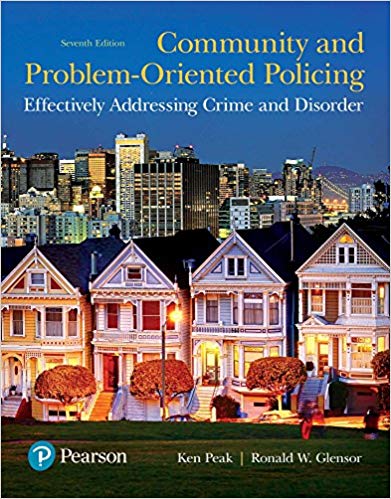(eBook PDF) Community and Problem-Oriented Policing: Effectively Addressing Crime and Disorder 7th Edition
$50.00 Original price was: $50.00.$35.00Current price is: $35.00.
(eBook PDF) Community and Problem-Oriented Policing: Effectively Addressing Crime and Disorder 7th Edition – Instant Download
(eBook PDF) Community and Problem-Oriented Policing: Effectively Addressing Crime and Disorder 7th Edition – Digital Ebook – Instant Delivery Download
Product details:
- ISBN-10 : 0133590100
- ISBN-13 : 978-0133590104
- Author: Kenneth Peak , Ronald Glensor
Community and Problem-Oriented Policing: Effectively Addressing Crime and Disorder, Seventh Edition, is about policing at its most important and challenging levels–in neighborhoods and communities across the nation. Unique in perspective, its focus is on community- and problem-oriented policing and the processes that are being implemented to control and prevent crime, disorder, and fear. Every chapter features Learn by Doing exercises to promote critical-thinking and analytical skills. Extremely applied, this text focuses on daily processes and tactics and how and why agencies are revolutionizing their traditional philosophy and operations.
The Seventh Edition addresses head-on the most challenging aspects of policing in our age. Individual chapters focus on community policing in terms of diversity, terrorism, homeland security, and police being more constitutional and legitimate. Expanded emphasis is placed on smart policing, predictive policing, and intelligence-led policing as well as applications of new information technologies for problem solving. Additionally, chapters examine major issues and challenging crime problems (e.g., drugs, gangs, youth and crime, neighborhood disorder, domestic violence, and human trafficking), crime prevention, changing agency culture, evaluating problem-solving initiatives, cyberbullying and cybercrime, and special populations, and the future. New case studies, exhibits, and examples offer readers a view of what works in policing strategy and problem solving in the field today.
Table contents:
PART I: THE LONG ROAD TO COMMUNITY POLICING AND PROBLEM SOLVING
1. Evolution: The Geneses of Community Policing
2. Community Partnerships: Building Accord in a Time of Discord
PART II: POLICING’S DUAL PRIORITIES: MANAGING DIVERSITY AND HOMELAND PROTECTION
3. Policing a Diverse Society
4. Protecting the Homeland: An International Problem for Local Police
PART III: PROBLEM SOLVING PROCESSES, PROGRAMS, AND PRACTICES
5. Problem Solving: A Process Model
6. Crime Prevention: Programs and Practices
7. Tools for Problem Solving: Using Information Technology
PART IV: NEEDED: ORGANIZATIONAL FOUNDATION FOR PROBLEM SOLVING
8. Changing Agency Culture: Toward Constitutional and Legitimate Policing
9. Planning and Implementation: Keys to Success
10. Training for Problem Solving: “Learning by Doing”
11. Evaluating and Assessing Outcomes: Do the Responses “Measure Up”?
PART V: ADDRESSING TODAY’S CRIME AND DISORDER
12. Problem Solving in Practice: “What Works” with Drugs, Youth Gangs and Violence, and Neighborhood Disorder
13. Addressing Offenders and Victims: Mental Illness, Domestic Violence, Cyber Criminals, Human Trafficking
PART VI: CHALLENGES AHEAD
14. Future Opportunities-and Obstacles
People also search:
compare and contrast community-based policing and problem-oriented policing
what is community oriented policing
what is problem oriented policing
difference between community policing and problem oriented policing
is problem oriented policing effective


